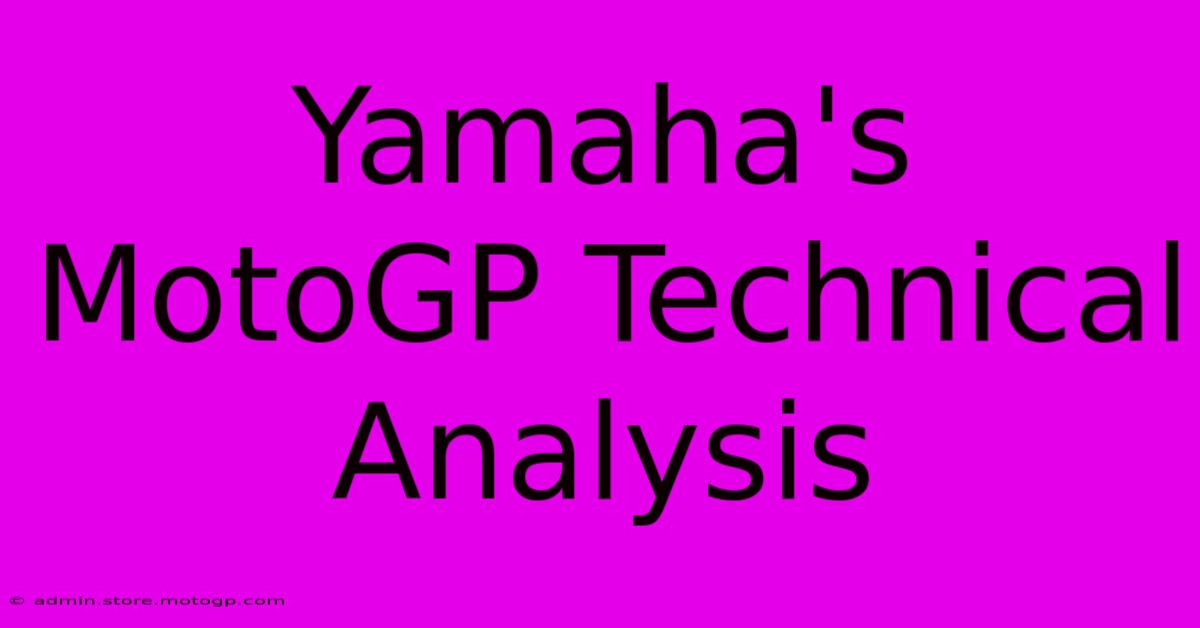Yamaha's MotoGP Technical Analysis

Table of Contents
Yamaha's MotoGP Technical Analysis: Unpacking the 2023 Season and Beyond
Yamaha's MotoGP campaign in 2023 has been, to put it mildly, a mixed bag. While the team boasts a rich history of success, the current season has highlighted some significant technical challenges. This article delves into a technical analysis of Yamaha's MotoGP efforts, exploring the strengths, weaknesses, and potential future developments.
The 2023 Yamaha M1: A Deep Dive into the Chassis and Engine
The Yamaha M1, historically known for its smooth engine character and agile handling, faced significant hurdles in 2023. Let's break down the key technical aspects:
Engine Performance: Power Deficit and Character
While Yamaha's engine has always been praised for its refined power delivery, many believe it has suffered from a power deficit compared to its competitors, particularly on long straights. This lack of outright power has severely hampered race pace and overtaking opportunities. Further analysis suggests the engine's character, while smooth, might not be perfectly suited to the current generation of MotoGP tires. This could be contributing to difficulties in maximizing tire life and overall performance.
Chassis Dynamics: Handling and Stability
The M1's chassis, once its greatest strength, has become a point of contention. Riders have reported inconsistencies in handling, particularly in terms of front-end feel and stability under braking. This points to possible issues with geometry, weight distribution, and the interaction between the chassis and the tires. Modifications to the chassis throughout the season suggest a continuous effort by Yamaha to address these problems, but a definitive solution remains elusive.
Aerodynamics: A Complex Equation
Aerodynamics play a crucial role in MotoGP, and Yamaha's approach has been a subject of much debate. While not overtly lacking in downforce compared to some competitors, the M1's aerodynamic package seems less adaptable to various track conditions. Optimizing the balance between downforce, drag, and stability represents a constant challenge. Further refinement and potentially more radical design changes may be necessary to bridge the gap with rivals.
Comparing Yamaha to the Competition
Comparing Yamaha's technical approach to its rivals like Ducati, Aprilia, and KTM reveals key differences. Ducati, for example, boasts superior outright power and impressive corner speed, highlighting Yamaha's deficit in engine performance. Aprilia's and KTM's advancements in aerodynamics and chassis design also present areas where Yamaha needs improvement.
The Path Forward: Potential Solutions and Future Developments
To regain competitiveness, Yamaha needs a multi-pronged approach:
Engine Development: Focus on Power and Torque
Addressing the power deficit is paramount. This likely involves significant development in engine architecture, internal components, and potentially even exploring alternative fuel and combustion strategies.
Chassis Refinement: Improving Front-End Feel and Stability
A comprehensive review of chassis geometry, suspension settings, and weight distribution is crucial. Yamaha needs to find a setup that provides consistent and predictable handling across various track conditions.
Aerodynamic Optimization: Adaptability and Downforce
Investing in advanced computational fluid dynamics (CFD) and wind tunnel testing is essential. This would enable the development of a more adaptive aerodynamic package that can be optimized for various track characteristics.
Rider Feedback and Data Analysis: Harnessing the Power of Information
Close collaboration between riders, engineers, and data analysts is crucial. Utilizing rider feedback effectively and analyzing data meticulously can provide valuable insights for targeted development.
Conclusion: Yamaha's MotoGP Journey Continues
Yamaha’s MotoGP journey in 2023 and beyond is a testament to the challenges and complexities of top-tier motorcycle racing. While the current situation is demanding, the team's history and engineering prowess suggest they possess the capabilities to overcome these hurdles. By addressing the identified technical weaknesses and strategically focusing on development in crucial areas, Yamaha can pave its way back to the front of the grid. The coming seasons will be crucial to see how effectively they implement these changes and reclaim their position as a major force in MotoGP.

Thank you for visiting our website wich cover about Yamaha's MotoGP Technical Analysis. We hope the information provided has been useful to you. Feel free to contact us if you have any questions or need further assistance. See you next time and dont miss to bookmark.
Featured Posts
-
Cota Apparel Comfort Meets Style
Feb 20, 2025
-
From Start To Finish Us Grand Prix Sprint Time Breakdown
Feb 20, 2025
-
The Sting Your Gateway To Formula 1
Feb 20, 2025
-
The Underdog Story Of The Grand Prix Who Won
Feb 20, 2025
-
The Challenges Of Bike Racing On Tv
Feb 20, 2025
